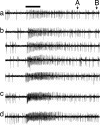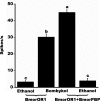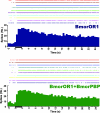Pheromone reception in fruit flies expressing a moth's odorant receptor
- PMID: 17060610
- PMCID: PMC1621046
- DOI: 10.1073/pnas.0607874103
Pheromone reception in fruit flies expressing a moth's odorant receptor
Abstract
We have expressed a male-specific, pheromone-sensitive odorant receptor (OR), BmorOR1, from the silkworm moth Bombyx mori in an "empty neuron" housed in the ab3 sensilla of a Drosophila Deltahalo mutant. Single-sensillum recordings showed that the BmorOR1-expressing neurons in the transgenic flies responded to the B. mori pheromone bombykol, albeit with low sensitivity. These transgenic flies responded to lower doses of bombykol in an altered stimulation method with direct delivery of pheromone into the sensillum milieu. We also expressed a B. mori pheromone-binding protein, BmorPBP, in the BmorOR1-expressing ab3 sensilla. Despite the low levels of BmorPBP expression, flies carrying both BmorOR1 and BmorPBP showed significantly higher electrophysiological responses than BmorOR1 flies. Both types of BmorOR1-expressing flies responded to bombykol, and to a lesser extent to a second compound, bombykal, even without the addition of organic solvents to the recording electrode buffer. When the semiochemicals were delivered by the conventional puffing of stimulus on the antennae, the receptor responded to bombykol but not to bombykal. The onset of response was remarkably slow, and neural activity extended for an unusually long time (>1 min) after the end of stimulus delivery. We hypothesize that BmorOR1-expressing ab3 sensilla lack a pheromone-degrading enzyme to rapidly inactivate bombykol and terminate the signal. We also found an endogenous receptor in one of the sensillum types on Drosophila antenna that responds to bombykol and bombykal with sensitivity comparable to the pheromone-detecting sensilla on B. mori male antennae.
Conflict of interest statement
The authors declare no conflict of interest.
Figures







References
-
- Fabre J-H. Souvenirs Entomologique; trans de Mattos AT The Life of the Caterpillar. Mead, New York: Dodd; 1916.
-
- Butenandt A, Beckmann R, Stamm D, Hecker E. Z Naturforsch. 1959;14b:283–284.
-
- Steinbrecht RA. Z Morph Tiere. 1970;68:93–126.
-
- Kaissling K-E, Kasang G, Bestmann HJ, Stransky W, Vostrowsky O. Naturwissenschaften. 1978;65:382–384.
-
- Kaissling K-E. In: R. H. Wright Lectures on Insect Olfaction. Colbow K, editor. Burnaby, BC, Canada: Simon Fraser Univ; 1987.
Publication types
MeSH terms
Substances
Grants and funding
LinkOut - more resources
Full Text Sources
Other Literature Sources
Molecular Biology Databases

